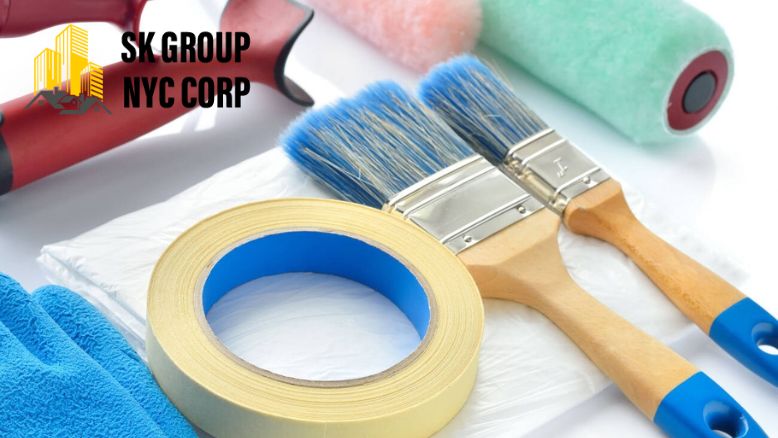Painting your NYC home can completely change the way it feels. But getting that smooth, flawless finish isn’t just about choosing a color it’s about following the right painting steps.
At SK Group NYC Corp, our expert painting services in NYC have helped homeowners transform their spaces beautifully and now, we’re sharing our pro painting tips so you can achieve a perfect finish too
Table of Contents
Understanding the Basics of Painting
Before you open the paint can, it’s important to understand how paint works. Paint isn’t just decoration it protects your walls from moisture, dirt, and damage. A good paint job adds value, beauty, and long-lasting protection to your space.
One of the most important painting tips for NYC homeowners is to focus on proper preparation. In New York City homes, where humidity, dust, and limited space can make painting tricky, choosing the right products and prepping your walls correctly makes all the difference.
1. Prep Is Everything
If you want professional-looking results, don’t skip the prep.
Clean your walls with mild soap and water to remove dust, grease, and stains. Fill cracks and holes, then lightly sand rough spots for a smooth surface.
We recommend using painter’s tape for clean edges and covering furniture or floors before you start. Remember great painting starts with great prep!
2. Always Use a Primer
One of the most common mistakes we see is skipping primer.
Primer helps paint stick better, last longer, and look smoother. Especially in older NYC apartments with patchy or textured walls, primer gives your paint an even base and boosts color brightness.
If you’re covering dark colors or painting new drywall, primer is a must.
3. Choose the Right Paint Finish
Different rooms need different paint finishes. Here’s a quick guide:
| Room Type | Recommended Finish | Why It Works |
|---|---|---|
| Living Room | Eggshell or Satin | Soft shine, easy to clean |
| Bedroom | Matte or Flat | Hides wall imperfections |
| Kitchen & Bathroom | Semi-gloss | Resists moisture and stains |
| Hallways | Satin | Durable and easy to wipe |
Choosing the right finish not only improves the look but also increases paint durability in busy NYC homes.
4. Pick Quality Paint
Cheap paint might seem like a deal, but it usually means more coats and quicker fading.
Invest in high-quality paints from trusted brands they last longer, cover better, and resist stains.
We use premium paints that can handle NYC’s humid summers and chilly winters without peeling or discoloring.
5. Don’t Paint in Humidity
NYC’s weather can be unpredictable. Painting on a humid day can cause your paint to dry slowly or unevenly.
Always check the weather forecast before painting ideally, choose a dry, mild day with good ventilation.
If you’re painting indoors, open windows and use fans to help the paint cure properly.
6. Apply Thin, Even Coats
More paint doesn’t mean better coverage. Thick coats can drip, bubble, or take forever to dry.
Always apply two thin coats instead of one heavy one for a professional finish. Let the first coat dry completely before applying the next.
7. Use the Right Tools
The tools you use make a big difference.
- Rollers: Great for large wall areas.
- Brushes: Best for edges, corners, and trims.
- Extension Poles: Perfect for reaching high ceilings safely.
High-quality brushes and rollers ensure smoother application and fewer streaks.
8. Test Colors Before Painting
Lighting in NYC apartments can be tricky what looks great in a store might look totally different at home.
Always test a small patch on your wall and observe it during different times of the day. Natural light and artificial light can both affect the final color tone.
9. Don’t Forget Drying Time
Many people rush between coats, but patience pays off.
Always wait for the first coat to fully dry before applying another. Otherwise, you’ll end up with uneven texture and peeling paint.
10. Call in the Pros (If Needed)
DIY painting is fun, but NYC homes often have unique challenges tight spaces, high ceilings, and older walls.
That’s where professionals like SK Group NYC Corp come in. We handle everything from prep to cleanup, giving your home a smooth, durable, and beautiful finish that lasts.
Customer Story
Last month, we helped a Brooklyn homeowner repaint their entire apartment. They had tried painting it themselves but faced uneven color and visible streaks.
Our team prepped, primed, and painted with the right materials and the result? A bright, clean, and professional look they loved. They told us, “We should’ve called you first!”
Final Thoughts
Painting your NYC home doesn’t have to be stressful. With the right painting tips, good preparation, and quality materials, you can achieve a flawless finish that makes your home look brand new.
And if you ever need help, remember SK Group NYC Corp is always here for you with expert painters, premium materials, and years of experience in NYC homes.
Have Questions? Call Us Now!
+1 (718) 507-7000
We’re here to help quick answers, friendly service, anytime you need!
Contact SK Group NYC
🌐 Website: www.skgroupnyccorp.com
📍 Serving: Manhattan, Brooklyn, Queens, The Bronx, and Staten Island
📍 Address: 87-88 172nd St, Jamaica, New York, NY, United States, New York

